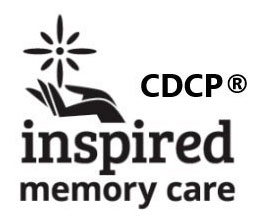Aging Answers Wilmington
Helpful tips for family caregivers
April/May 2015
Time for some spring cleaning: in the legal department, in the dental department, and in your mental environment.
Does the advance directive need updating?
Once an advance directive for healthcare is complete, most of us want to set it aside as “DONE.”
But circumstances, priorities, and preferences all change with time. Consider a review and an update with any of these life events:
- Change in health. Hospitalization or a serious illness may change life priorities and end-of-life wishes. Be sure to revise the advance directive to reflect these changes. Don’t forget to share new perspectives with the person who has been chosen to make those decisions (the healthcare agent).
- Age. Is this a “zero” birthday year, starting a new decade of life? That’s a great review trigger. But once your relative reaches age 70, you might step up the pace and review the directive on every “even year” birthday (72, 74, 76, and so on).
- Death. You or your relative may have experienced the death of a loved one since the last directive was written. This may shed new light on end-of-life preferences. It may also reveal who is the person best able to serve as the healthcare agent. It’s important to note the people named (including alternates) and to consider if they are still the best people for the job. If not, take the time to document the preferred healthcare agent.
- Marriage. Has there been a marriage (or divorce)? Does this alter the thinking about who should be the healthcare agent? Update the document with any name changes.
- Move. Has your relative moved permanently to a new state? Every state has its own advance directive form. Make sure you are using the legally valid form for the new state of residence.
Once an update is completed, destroy all outdated versions. Distribute copies of the new document using the guidelines in our earlier article about tips to ensure you can find the advance directive when you need it.
Return to topPreventing dental disease
Older adults are at high risk for cavities and other dental problems. The steps to prevention are not complicated. But aging makes some special strategies necessary.
Flossing and brushing teeth are powerful basics. The guideline is to floss once a day and brush at least twice a day, using a soft-bristle brush. Arthritic joints and numbness in fingers can make these tasks difficult. If your relative has problems, consider
- making an oversized handle on the toothbrush. Make a built-up handle by wrapping it in foil or bubble wrap
- switching to an electric toothbrush. Electric toothbrushes have larger handles and timers to ensure a two-minute brush
- consulting with the dentist about floss alternatives. There are special floss holders that keep the string taut and make it easier to floss. In some cases, the best alternative is a toothpick or water floss appliance
- buying toothpaste in a pump-style dispenser. This eliminates the hassle of removing the cap or squeezing out the paste
The dentist may also recommend daily use of a fluoride rinse or gel.
Adequate saliva is essential to cavity control. Unfortunately, more than 400 prescription and over-the-counter drugs are known to cause dry mouth. Review your loved one’s medicines with the doctor or pharmacist. Ask if there are alternatives that do not have a “dry mouth” side effect. Also have your relative
- limit use of caffeine, alcohol, and tobacco
- drink lots of water and/or sugar-free beverages
- suck sugar-free candy to stimulate saliva production. Or chew gum with xylitol, a sugar substitute shown to prevent cavities
- use an alcohol-free, antibacterial mouthwash
Twice-yearly dental exams and oral cleanings are key. This permits early detection and treatment of cavities, gum conditions, and lesions in the mouth. Cleaning removes cavity-causing plaque and keeps gums healthy. If your relative can’t or doesn’t brush regularly, you might have him or her see the dental hygienist more often.
Return to top
Removing "junk stimulation"
 If you were asked to name the stresses in your life, you might think first about all the tasks and responsibilities you are juggling. Or challenging relationships. Or financial difficulties.
If you were asked to name the stresses in your life, you might think first about all the tasks and responsibilities you are juggling. Or challenging relationships. Or financial difficulties.
Less obvious are the stressors in your environment that can tax your nervous system behind the scenes.
“Junk stimulation,” like junk mail, simply overwhelms the brain for no real purpose. Clutter and noise are two stimulants that create unnecessary stress.
- Clutter. Studies clearly show a link between physical clutter and stress. Clutter distracts. It calls for our attention and limits our ability to focus. Getting rid of clutter is like changing any bad habit. Start small with an area where you can see noticeable improvement. Consider five minutes to de-clutter one shelf or one drawer each day. Or dedicate an hour or two on a Saturday to de-clutter one room. Arm yourself with three boxes or sturdy bags: Trash, Recycle, and Give Away. Remember the guideline: If you haven’t used it in a year, you don’t need it. You’ll be surprised at how clear your mind feels when you are not tripping on clutter, searching for “lost” items, or bombarded with overly abundant visual input.
- Noise. Stop and listen. Do the sounds you hear really add to your well-being? Loud noises. Unpredictable noises. Noises we can’t control. Noises with negative content. These are the sounds that distract our attention and disturb our ability to think or remember well. If traffic noise is irritating, can you open a different window to let in less street noise? Turning down the ringer on your phone can reduce that jangled feeling when the phone rings. If the TV is blaring, will the viewer wear headphones? Or could the TV be relocated into a room with a door? Eliminating unwelcome sounds is a great way to give your nervous system a rest.



